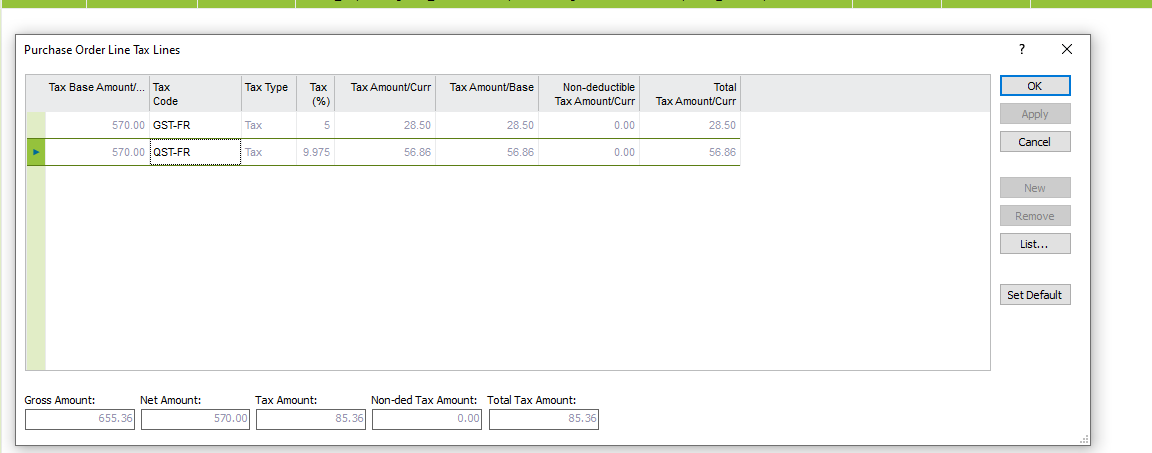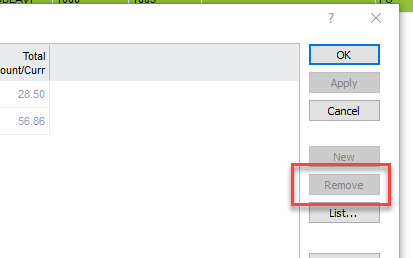The only other option I know of would be a permission change unless there is a setting to include tax in the price that will limit changes.
I found some information specific to this via F1:
Manage Tax, Purchase Order Line/Manage Tax, Purchase Order Change Order Line
Explanation
Use this function to handle taxes in connection to purchase order line and purchase order change order line. You can enter tax information directly on the purchase order line and purchase order change order line or work with multiple taxes. If you select tax structure you can work with mutiple taxes with different tax base amounts. If you work with multiple taxes without selecting tax structure you can add, modify or remove tax lines. Default tax information can also be retrieved.
Taxes entered on purchase orders are considered estimated until invoiced and paid.
Prerequisites
- Purchase order or purchase order change header with at least one order line must exist in the Purchase Order window or Purchase Order Change Order window.
- The Taxable check box in the purchase order or purchase order change order line must be selected.
- The tax codes to be applied must have been defined for the company used. This is done in the Tax Codes window.
- To calculate single tax or multiple taxes with the common tax base amount
- Purchase part must be taxable. This is done in the Purchase Part window. For no part order lines this is done on the Company/Tax Control/Sales and Procurement tab under Purchasing.
- To receive default tax values for the purchase part, the tax code must be connected to the part. This is done in the Supplier for Purchase Part window. To receive default tax values for no part order line when the tax liability is of tax liability type Taxable, the tax code must be specifed for supplier or company. This is done on the Supplier/Invoice/Tax Information tab and the Company/Invoice/Tax Information tab. To receive default tax values for no part order line when the tax liability is of tax liability type Exempt, the tax free tax code must be specifed for supplier or company. This is done on the Supplier/Invoice/Tax Information tab and the Company/Invoice/Tax Information tab.
- To receive default tax values for the taxable scenario from the supplier address, the tax liability must be of tax liability type Taxable, the Use Supplier Address for Tax check box must be selected on the Supplier/Address/Delivery Tax Information tab and one or more tax codes must be connected to the supplier's delivery address on the Supplier/Address/Delivery Tax Information tab.
- To receive default tax values for the taxable scenario from the company address, the tax liability must be of tax liability type Taxable, the Use Supplier Address for Tax check box must not be selected on the Supplier/Address/Delivery Tax Information tab and one or more tax codes must be connected to the company's delivery address on the Company/Address/Tax Information tab. Purchase order or purchase order change order line should not be connected to project activity.
- To receive default tax values for the taxable scenario from the project address,the tax liability must be of tax liability type Taxable, the Use Supplier Address for Tax check box must not be selected on the Supplier/Address/Delivery Tax Information tab and one or more tax codes must be connected to the project delivery address on the Project/Addresses/Tax Information tab. Purchase order or purchase order change order line should be connected to project activity.
- To calculate multiple taxes with different tax base amounts
- Purchase part must be taxable. This is done in the Purchase Part window. For no part order lines this is done on the Company/Tax Control/Sales and Procurement tab under Purchasing.
- The tax calculation structure to be applied must have been defined for the company used. This is done in the Tax Calculation Structure window.
- To receive default tax values for the taxable scenario from the supplier address, the tax liability must be of tax liability type Taxable, the Use Supplier Address for Tax check box must be selected on the Supplier/Address/Delivery Tax Information tab and tax structure must be connected to the supplier's delivery address on the Supplier/Address/Delivery Tax Information tab.
- To receive default tax values for the taxable scenario from the company address, the tax liability must be of tax liability type Taxable, the Use Supplier Address for Tax check box must not be selected on the Supplier/Address/Delivery Tax Information tab and tax structure must be connected to the company's delivery address on the Company/Address/Tax Information tab. Purchase order or purchase order change order line should not be connected to project activity.
- To receive default tax values for the taxable scenario from the project address,the tax liability must be of tax liability type Taxable, the Use Supplier Address for Tax check box must not be selected on the Supplier/Address/Delivery Tax Information tab and tax structure must be connected to the project delivery address on the Project/Addresses/Tax Information tab. Purchase order or purchase order change order line must be connected to project activity.
System Effects
- Tax information is entered and connected to a specific purchase order or purchase order change order line. If single tax is calculated, the Multiple Tax Lines check box is not selected and single tax code is displayed in the Tax Code column on the line. If multiple taxes are calculated, the Multiple Tax Lines check box is selected on the line. If multiple taxes with different tax bases are calculated, the tax calculation structure is displayed in the Tax Calculation Structure column on the line.
- If the Transaction Level check box is selected on the Company/Tax Control/General tab under Supplier Tax under Tax Code Validations, it is mandatory to enter a tax code or a tax calculation structure on the purchase order or purchase order change order line.
- If the Use Price Incl Tax check box is not selected on the Purchase Order/Misc Order Info tab, net amount from purchase order or purchase order change order line is used as tax base.
- If the Use Price Incl Tax check box is selected on the Purchase Order/Misc Order Info tab, gross amount from purchase order or purchase order change order line is used as tax base.
- If multiple taxes with different tax bases are calculated, the tax base for each tax line is derived from the tax calculation structure definition and it is displayed in the Tax Base Amount/Curr column.
- Total tax amount, deductible tax amount and non deductible tax amount are calculated for each tax line.
- Total tax amount, deductible tax amount and non deductible tax amount are calculated for purchase order or purchase order change order line.
- If the Use Price Incl Tax check box is not selected on the Purchase Order/Misc Order Info tab, gross amount on purchase order or purchase order change order line is calculated as a sum of net amount and tax amount.
- If the Use Price Incl Tax check box is selected on the Purchase Order/Misc Order Info tab, net amount on purchase order or purchase order change order line is calculated as a difference between gross amount and tax amount.
- If multiple taxes with different tax bases are calculated, gross amount on purchase order or purchase order change order line is calculated as a sum of net amount and tax amount.
Procedure
- Select the purchase order or purchase order change order line whose tax information you want to view.
- If you want to use single tax code, enter the appropriate tax code in the Tax Code column, either by entering the short code or using the List of Values.
- If you want to use tax calculation structure, enter the appropriate tax calculation structure in the Tax Calculation Structure column, either by entering the short code or using the List of Values.
- Save the record.
- If you want to enter more tax codes or change tax codes for the purchase order line, right-click, point to Order Line Details and then click Order Line Taxes. The Purchase Order Line Tax Lines window opens displaying any existing tax lines for the purchase order line. If you want to enter more tax codes or change tax codes for the purchase order change order line, right-click and then select Order Line Taxes. The Purchase Order Line Change Order Tax Lines window opens displaying any existing tax lines for the purchase order change order line.
- To add a new tax line, click New, and then click List and select a tax code. Note: You can only add a new tax line when tax calculation structure is not used.
- To edit a tax line, select a tax line and enter the appropriate tax code in the Tax Code column, either by entering the short code or using the List of Values.
- To remove a tax line, select the tax line and then click Remove. Note: You can only remove a tax line when tax calculation structure is not used.
- To receive default tax information, click Set Defaultt.
- Click Save to save and close the window. The resulting amounts will be transferred to the purchase order or purchase order change order line.






